#Contextual Sensitivity
Explore tagged Tumblr posts
Text
Key Differences Between AI and Human Communication: Mechanisms, Intent, and Understanding
The differences between the way an AI communicates and the way a human does are significant, encompassing various aspects such as the underlying mechanisms, intent, adaptability, and the nature of understanding. Here’s a breakdown of key differences:
1. Mechanism of Communication:
AI: AI communication is based on algorithms, data processing, and pattern recognition. AI generates responses by analyzing input data, applying pre-programmed rules, and utilizing machine learning models that have been trained on large datasets. The AI does not understand language in a human sense; instead, it predicts likely responses based on patterns in the data.
Humans: Human communication is deeply rooted in biological, cognitive, and social processes. Humans use language as a tool for expressing thoughts, emotions, intentions, and experiences. Human communication is inherently tied to understanding and meaning-making, involving both conscious and unconscious processes.
2. Intent and Purpose:
AI: AI lacks true intent or purpose. It responds to input based on programming and training data, without any underlying motivation or goal beyond fulfilling the tasks it has been designed for. AI does not have desires, beliefs, or personal experiences that inform its communication.
Humans: Human communication is driven by intent and purpose. People communicate to share ideas, express emotions, seek information, build relationships, and achieve specific goals. Human communication is often nuanced, influenced by context, and shaped by personal experiences and social dynamics.
3. Understanding and Meaning:
AI: AI processes language at a syntactic and statistical level. It can identify patterns, generate coherent responses, and even mimic certain aspects of human communication, but it does not truly understand the meaning of the words it uses. AI lacks consciousness, self-awareness, and the ability to grasp abstract concepts in the way humans do.
Humans: Humans understand language semantically and contextually. They interpret meaning based on personal experience, cultural background, emotional state, and the context of the conversation. Human communication involves deep understanding, empathy, and the ability to infer meaning beyond the literal words spoken.
4. Adaptability and Learning:
AI: AI can adapt its communication style based on data and feedback, but this adaptability is limited to the parameters set by its algorithms and the data it has been trained on. AI can learn from new data, but it does so without understanding the implications of that data in a broader context.
Humans: Humans are highly adaptable communicators. They can adjust their language, tone, and approach based on the situation, the audience, and the emotional dynamics of the interaction. Humans learn not just from direct feedback but also from social and cultural experiences, emotional cues, and abstract reasoning.
5. Creativity and Innovation:
AI: AI can generate creative outputs, such as writing poems or composing music, by recombining existing patterns in novel ways. However, this creativity is constrained by the data it has been trained on and lacks the originality that comes from human creativity, which is often driven by personal experience, intuition, and a desire for expression.
Humans: Human creativity in communication is driven by a complex interplay of emotions, experiences, imagination, and intent. Humans can innovate in language, create new metaphors, and use language to express unique personal and cultural identities. Human creativity is often spontaneous and deeply tied to individual and collective experiences.
6. Emotional Engagement:
AI: AI can simulate emotional engagement by recognizing and responding to emotional cues in language, but it does not experience emotions. Its responses are based on patterns learned from data, without any true emotional understanding or empathy.
Humans: Human communication is inherently emotional. People express and respond to emotions in nuanced ways, using tone, body language, and context to convey feelings. Empathy, sympathy, and emotional intelligence play a crucial role in human communication, allowing for deep connections and understanding between individuals.
7. Contextual Sensitivity:
AI: AI's sensitivity to context is limited by its training data and algorithms. While it can take some context into account (like the previous messages in a conversation), it may struggle with complex or ambiguous situations, especially if they require a deep understanding of cultural, social, or personal nuances.
Humans: Humans are highly sensitive to context, using it to interpret meaning and guide their communication. They can understand subtext, read between the lines, and adjust their communication based on subtle cues like tone, body language, and shared history with the other person.
8. Ethical and Moral Considerations:
AI: AI lacks an inherent sense of ethics or morality. Its communication is governed by the data it has been trained on and the parameters set by its developers. Any ethical considerations in AI communication come from human-designed rules or guidelines, not from an intrinsic understanding of right or wrong.
Humans: Human communication is deeply influenced by ethical and moral considerations. People often weigh the potential impact of their words on others, considering issues like honesty, fairness, and respect. These considerations are shaped by individual values, cultural norms, and societal expectations.
The key differences between AI and human communication lie in the underlying mechanisms, the presence or absence of intent and understanding, and the role of emotions, creativity, and ethics. While AI can simulate certain aspects of human communication, it fundamentally operates in a different way, lacking the consciousness, experience, and meaning-making processes that characterize human interaction.
#philosophy#epistemology#knowledge#learning#education#chatgpt#metaphysics#ontology#AI Communication#Human Communication#Language Understanding#Natural Language Processing#Machine Learning#Cognitive Science#Artificial Intelligence#Emotional Intelligence#Ethics in AI#Language and Meaning#Human-AI Interaction#Contextual Sensitivity#Creativity in Communication#Intent in Communication#Pattern Recognition
5 notes
·
View notes
Text
How does one address the social and economic needs of a region through architectural interventions?
Addressing the Social and Economic Needs of a Region through Architectural Interventions Introduction Architectural interventions have the power to address the social and economic needs of a region by creating built environments that cater to the well-being and prosperity of the community. Beyond the functional aspects, architecture has the potential to shape social interactions, enhance…

View On WordPress
#accessibility#adaptive reuse#affordable housing#architectural interventions#community engagement#community facilities#contextual sensitivity#economic needs#flexible spaces#green infrastructure#inclusivity#mixed-use developments#public spaces#social needs#sustainable design
1 note
·
View note
Note
hi cianna sorry for the really broad question but it really smart and ur soul is beautiful and i think lowkey if i asked this irl people would get very worried so i’m asking u. any advice 4 a girl in her late teens who’s just now coming out of a 4-5 year long slump of wanting to kill herself real bad and now needs to be a functioning person and pass exams and go to university next year ect. ?
Hi this literally happened to me in my teen years!! I was not suicidal, but I def had a major slump I had to pull myself out of by uni. Here are some things I think could’ve worked better for me - feel free to disregard at your discretion/based on your circumstances :)
Get therapy!! Teenage me would’ve benefited from it so much. There are therapists who’d be happy to give you student discounts. You’ll be going through a lot of change - re learning how to take care of yourself, discovering your boundaries, battling regret for wasting time etc etc… it’s just better to go through it w a professional who would show you compassion but also push you to improve. It’s not a substitute for real friendships, but it absolutely helps
Ignore people who will tell you they peaked in hs (lol). This will be a lot of people btw. You’ll get major fomo bc you’ll be like?? I didn’t do any of that. I was too busy surviving. I won’t have things to look back at the way they do. But that’s where the uphill battle of saying no to fomo comes in - you have to remind yourself that you’re at the beginning of your life, that you could completely turn it around in college, and peaking in hs is like actually sad and that what matters is the life you make for yourself moving forward
People (family and teachers) want to help. So let them
Push yourself but don’t overcorrect. The antidote to not having friends is not overextending yourself and saying yes to everything and having no boundaries and burning out. Pace yourself. Trying to become someone completely different is also a sign you don’t like yourself very much
You have to aggressively combat the self hatred and re affirm to yourself day by day that you deserve good things and that you are enough and that you don’t need other people to imbue your life and give it dimension. They are a nice bonus but it’s all in you
Hot take but be careful w self help content. It preys on people in vulnerable stages (like you) and is easy to get addicted to
I don’t know where you stand w your phone, but decrease phone time. It’s very personal to everyone how they can accomplish this, so research all the different methods and apply what best fits you / what you think you can stick by best!
Cliche advice is true - getting out of the slump starts w things like a simple skincare routine and an outfit you feel good in
Say yes to things more often. Try to approach people more often, even if it gives you rejection sensitivity. I wish I did this more tbh - I think I did put myself out there but was inconsistent. No “social fuck ups” will matter at your age so just try to learn as much as you can
You have to contextualize this hard time period of your life as a learning experience that gave you a sort of depth that is rarely seen in most people. It wasn’t all for nothing — it shaped you into you
You’re defined by who you are and the values you have — not the person you used to be. The imposter syndrome in you might be like “everyone knows I was xyz girl who didn’t talk to anyone and could not even turn an assignment in on time,” but what are you now? Are you trying to befriend people now? Getting a lot better at managing your time now? Doing really good in school now? That’s who you are.
Unconventional advice but get a cute job at a library or a cafe or something. It will re introduce discipline into your system and acquaint you w people your age
Exercise really really really really really helps. It can start simple but it has to be started
Research programs you want to get into. Make a game plan in accordance to that. Talk to your advisor about it
Join clubs in college :) talk to people but don’t overextend yourself if they don’t reciprocate - you have plenty of time to make friends :)
Journal more. It helps!!!!
The world is not out to get you
Cliche but true - reading helps so much. Even just one book at a time at your own pace. Luckily I was reading so much in my teen years but I’m telling u this in case it’s not really part of ur palette
What’s the hobby that really speaks to your soul?? Aggressively pursue it
Romanticizing simple things helps tbh
Do not hate yourself into getting better!! You were just a child who did the best they can w the cards they were dealt. Now you’re saying enough to passive living and making active effort to get out of your slump — and that matters more than anything. You will experience the FOMO and the regret and the “why didn’t I do xyz when I was younger.” Everyone does, but for you it will be exacerbated bc you’ll feel like you wasted an epoch of your life everyone else romanticizes. This is where therapy and radical acceptance come in — and also just brutally reminding yourself of the facts, including how you’re so very incredibly young. Time is on your side and you can do anything you want
I’m so proud of you for taking the first step — which is understanding the problem!! I know I wasn’t that brave at your age. Good luck with everything xx
165 notes
·
View notes
Text
Armand mentioning Tintoretto alludes to Amadeo's backstory:
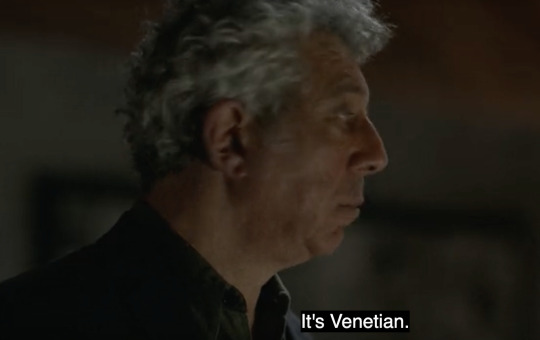

Tintoretto's first major painting in Venice was "The miracle of the slave" (also known as 'San Marco freeing the slave'). "It was the first notable work of Tintoretto's career."

In TVA, not only did Amadeo often visit san marco square, and enjoy looking at the artwork depicting 'san-marco' ( aka: 'saint mark' , the patron saint of venice). Amadeo even thought of San-marco's plaza right before Marius started whipping and beating him. The difference being, san-marco didn't save Amadeo from torture (and break the whip) of his master. Amadeo the vampire just thought to himself "i'm the slave of a tyrant" as he looked at the whip.It's probable Amadeo related to the Catholic slave (in the painting) who was stripped naked , beaten, and later saved by San-marco . Because Amadeo as a child- slave held reverence for San-Marco growing up . Which makes sense... even before the painting was commissioned , he may have heard the story of San-marco saving the slave (since the painting is based on the 'golden legend': a collection of hagiographic sources, depicting various saints' backstories). The venetian painting ('miracle of the slave') was even stolen by the French: similar to Amadeo being kidnapped and forced to leave Venice and go to Paris.
The vampire Armand excerpts: (pov of Amadeo in the 1st person talking about san marco, these excerpts were sprinkled all over the book, there was like 9 other refs to san-marco I didn't add):

Amadeo being whipped by marius (cough not the first time he did this to Amadeo, just the first time he did this to him post-vampirism):


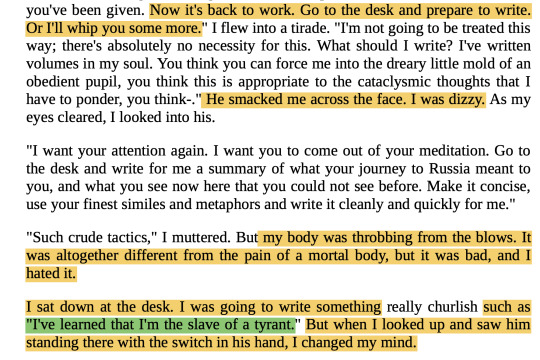
Armand's backstory is going to kill me! I know the show writers are going to write it better than AR & re-contextualize and write it in a much more sensitive way: that's much more tragic and layered (cause the writers are clearly galaxy-brained , adding these type of small details).
Also, Armand saying part of his backstory to Daniel in s2e3, asking young Daniel if he wanted to "hear his story" & mentioning this Tintoretto easteregg to Daniel: pretty much confirms to me Armand will eventually open up and tell Daniel his whole story. Show-Daniel will probably steal that plot line from David (who wrote TVA with Armand).
113 notes
·
View notes
Note
Do you know why people refer to Fiona as a character of color? I've seen posts about her in DAI vs. her in the novel that quoted how she is a different character personality-wise but not stuff about her race. This is in good faith, since you seem to be supplementary DA materials expert :)
She's Alistair's mother, and Alistair has naturally light brown skin in DAO. (Do not go by the thousands of whitewashed fan works. He literally uses the skin tint 004 of 6 options. He's about the same if not a little darker than Fenris for fuck sake. But he's been progressively whitewashed each subsequent game until in DAI he's a completely redesigned character, with the whitest skin available and orange hair. It's gross.) Compared to Cailan in DAO and official art of Maric, this suggests he must have inherited it from Fiona's side of the family.
Fiona in The Calling is described to have dark hair and brown eyes, but is never explicitly described to be any specific ethnicity. Some people have pointed out that Gaider did use the word 'pale' for her - ignoring for a second that pale does not automatically mean white - but he's a bad writer who also calls Duncan of all characters 'pale' in the same context to describe ill health. Duncan, who in the same book is also described to have dark skin. Gaider just sucks at describing characters besides comments about how 'exotic' elven women are.
Contextually/narratively, even ignoring Alistair's existence for a second, it is pretty easy to read Fiona is nonwhite in The Calling. While you could try to argue that this is just because she's an elf and all elves are coded as nonwhite, I would argue in response... why does your belief start and end with just coding?
After MANY years defending myself and others who see Fiona as nonwhite in this fandom from horrible racist assholes, this is a very sensitive topic for me. I am not interested in debating it any longer. If you wish to see her as white, go do it somewhere else, because I don't want that anywhere near my blog.
95 notes
·
View notes
Text
Organ donation, compassion fatigue, and Japanese perspectives on brain death
I don’t think Shidou’s sin was actually a crime (as in, it was perfectly legal) and I’m going to explain why. This is essentially a very long Kirisaki Shidou Is Not An Organ Harvester post

To start: Shidou’s sin was convincing the families of braindead patients to donate their relatives’ organs. He confirms doing this in his T2 voice drama, and the way he words it makes it clear he thinks of it as murder. (He does say that this is only half of his sin, but we’ll get to the other half later.)
You know, I… continuously tried to persuade the relatives of braindead patients who were against organ transplants.
“In order to save the life of someone you don’t know, please let me kill your family member,” I told them.
It doesn’t even take much thinking to realize how cruel that is, but… I didn’t realize that until the very end.
Translation used: https://youtu.be/9xmokVJ-6x4?si=VgcIp5LCdNnUwqUW
Brain death is the irreversible, complete loss of brain function, meaning there’s no chance for a braindead patient to ever come back. Because of this, some people may feel that removing life support from a braindead patient doesn’t constitute murder. It definitely doesn’t constitute murder from a legal perspective, but it makes sense why someone might think of it as murder— especially in Japan.
Japanese perspectives on brain death
In evaluating Shidou’s case, we have to consider the cultural context within which it was written. Many people in Japan do not consider brain death as human death, and brain death cannot be declared without consent from the family and the intention to donate organs. In fact, braindead patients are not removed from life support until their heart stops beating. Shidou isn’t being dramatic when he frames his words as basically saying, “please let me kill your family member.”
Brain death is a very contentious topic in Japan—Doctors are put under scrutiny for declaring brain death and performing organ transplants. It’s important to know that in Japan, brain death only exists in relation to organ transplants. And only certain designated hospitals will do this. Even more so, if a person writes an advance directive asking to be taken off of life support in the case of brain death, doctors are not required to follow it. And many of them don’t, out of fear of the patient’s family lashing out at them.
Only in 2010 was Japan’s Organ Transplant Law revised so that organ transplants could be performed without prior consent from the brain dead patient (now only requiring consent from the family).
Here’s a couple of scholarly articles on the topic if you’d like to read more about it.
https://doi.org/10.1186%2Fs12910-021-00626-2
https://doi.org/10.1353/nib.2022.0019
Another very important facet of this discussion is how low organ donation rates are in Japan. To give you an idea, here’s a chart showing the per million population of donations after brain death (DBD) and donations after cardiac death (DCD) in a few different countries.

Sourced from this article, which has some other interesting statistics as well: https://doi.org/10.1016/j.tpr.2023.100131
As you can see, Japan’s rates are astronomically low in comparison to other countries. This helps to contextualize why Shidou had to try so hard to persuade families to donate, and why he later became extremely desperate when his wife’s life was on the line.
I’ve seen a lot of people confused about Shidou’s crime, and many speculations about him doing heinous things such as organ harvesting or purposefully botching surgeries—but I think this is because we’re approaching the case with a western perspective. As we know, many (if not all) of the Milgram prisoners represent a controversial social issue. Brain death is not nearly as divisive in western medicine as it is in Japan, so it’s easy to overlook the idea that all Shidou actually did was take organs from braindead patients. Perspectives on brain death in Japan have changed a lot in the past couple of decades, but it’s still quite controversial; because of this, I truly believe that this is the point of contention behind Shidou’s case, and there’s nothing more sinister secretly going on.
Compassion fatigue
Compassion fatigue is commonly thought to be the manifestation of secondary traumatic stress and burnout, caused by caring for others who are in stressful situations. This commonly affects people who work in healthcare.
I believe Shidou experienced compassion fatigue from working in the hospital, as he exhibits some of the symptoms—in particular, a reduced sense of empathy and a detachment from others.
I feel that Throw Down makes a lot of sense when you view it from this angle.
Lyrical analysis on Throw Down


Shidou expresses that he no longer remembers what it feels like to take away in order to give.

Pomegranates represent death in Greek mythology, and I believe that’s what they represent here too. Shidou has become desensitized to death; the pomegranate no longer has any flavor.
If it’s not needed, I’m not interested
Shidou only thought about what was physically necessary to keep a patient alive, and remained emotionally distant.
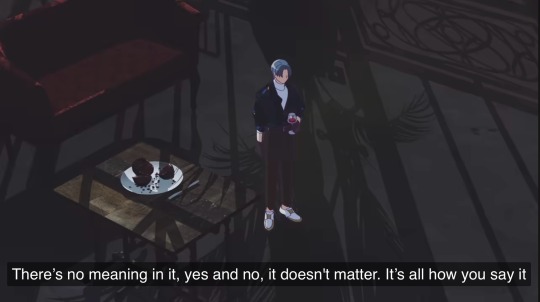
They’re dead either way, so it doesn’t really matter to him.
Now slowly close your eye, put your regret on display
Wish for being there for someone
With the same expression no matter who comes
This is the part that most makes me think of compassion fatigue—Shidou had difficulty expressing empathy for grieving families and had to fake it.
I don’t feel scared because I don’t know
Shidou didn’t understand what it was like to be in that situation. But now that it’s happened to him… he understands. And, looking back, he understands how unkind he had been about all of it. This is why he considers himself to be a murderer, why he truly believes that he has killed many people.
Ethics is a delusion
This is a line that definitely struck me as odd for awhile, but I think it makes sense in the context of his situation. His sin was not illegal—but is it ethical? That’s what all of this—whether you forgive him or not—hinges on.
The other half of Shidou’s sin
Going back to what I said earlier, Shidou’s sin wasn’t only convincing families to donate their relatives’ organs. His sin is also transplanting his son’s organs in an attempt to save his wife.
I believe that Shidou’s family got into a car accident, which resulted in his older child experiencing brain death and his wife being left in critical condition (and the younger child presumably died immediately). Considering the views surrounding brain death in Japan, it would have been difficult to find a donor, so Shidou became desperate enough to transplant his son’s organs. Since he’s the father, there wouldn’t have been any issues with receiving consent for the transplant.
Some people believe it’s the other way around—that he transplanted his wife’s organs into his son—but I believe otherwise, for multiple reasons.
In Shidou’s T1 voice drama, he expresses relief at the fact that his judgment is being determined by Es, who is a child. This makes sense if he feels that he killed his son.
Instead of being told by the law that I won’t be forgiven, I wanted a child like you, Es, to tell me that.
I feel sorry that you had to be given this role. And, I truly apologize for being so insistent about sentencing me to death as well… But, you’re perfect. You’ll give me the ending I’m most suited for.
Translation used: https://youtu.be/C4MiQ3V3YjQ?si=hPmlUkc6BfdcacNg
Additionally, a few scenes in Triage…
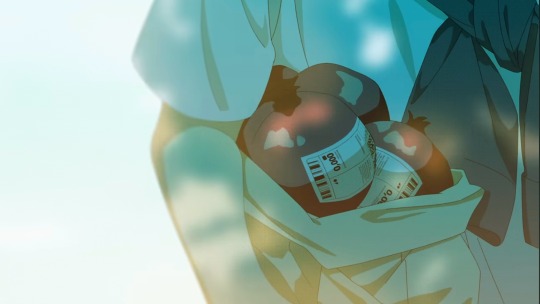
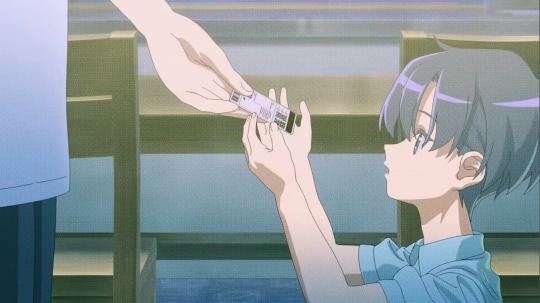
As stated before, I interpret the pomegranates to represent death. Shidou brings home three pomegranates, one for each of his family members. He later hands his son a price tag from the pomegranates—a representation of Shidou sentencing him to death.
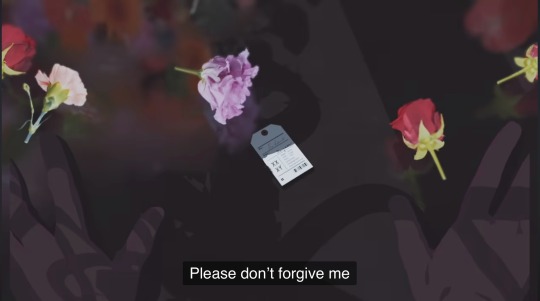
And at the end of Throw Down, an organ tag falls out of the flower person. The name seems to read “Rei Kirisaki” and has XY marked, probably indicating that the donor is male.

Not to mention, it’s much more plausible for the flower person to represent Shidou’s wife rather than his son. When the person falls apart, there’s a shot of a red rose—the flower most known for representing romantic love—falling out of them.
Final thoughts and conclusion
To summarize: Shidou used to routinely try to persuade the families of braindead patients to donate their relatives’ organs. Despite that the prevailing thought in Japan is that brain death is not human death, Shidou did not think of it this way.
Shidou’s family later got into an accident; he transplanted his braindead son’s organs in an attempt to save his wife, but it was a failure, resulting in her death. This situation made him reflect on his past actions—he did not consider it murder before to discontinue life support on a patient, but now that he did it to his son, his perspective has changed. Everything he has done is within the confines of the law, but he is now burdened with immense guilt and thinks himself a murderer. Not just in regards to his son, but to all of the patients that he had pulled the plug on.
Side note: I don’t think having low empathy is inherently a bad thing (I have naturally low empathy), but in this context it would make sense for Shidou to feel bad about lacking empathy.
Side note 2: Shidou is a surgeon, so it is entirely possible he personally performed the transplant on his wife. Operating on family members isn’t illegal or anything, but is widely considered to be unethical and not really a good idea.
Well, that’s all I had to say—Feel free to either add on to this theory or debate me on it. This post ended up quite long, so thank you for reading!
280 notes
·
View notes
Text
Look man I too miss DamiAnya and want to learn more about Anya's and Yor's past but that doesn't mean that the current arc is "badly paced", in fact I think the pacing is actually excellent. Endo is handling an extremely sensitive (and sadly painfully relevant) topic with so much care and respect. I don't think it's a stretch that most people have been affected by war in one way or another, be it recently or in the past.
These flashbacks are also re-contextualizing two side-characters who will most likely play an important role later. Not to mention all the lore and even young Donovan!
Like Imma be real I think a good chunk of the fandom is too impatient and even counting months of when character xyz last appeared. That's not exactly fair to mangaka and their schedule. Let Endo cook!!!
#spy x family#sxf spoilers#sxf fandom#Like damn if u can't wait just go read something else#In fact yall should read one piece lol#Yes I'm biased cause op is my current hyperfixation but ALSO because Oda is a master of fleshing out side characters#And then said character is re-contextualized and it's a delight while rewatching/reading the series again
251 notes
·
View notes
Note
I am appalled that sometimes, my prayers come in the form of cuss words, especially when I’m in pain or I feel lost.
I'm not, beloved!
I mean, I don't know what exactly you're saying, but that's how most curse words came into being, I'd imagine. Research points to swearing actually helping with (physical) pain. Most people swear at least once in their lives.
We only have human language with which to approach God. You're using the strongest/angriest/most evocative words in your language to try to express the pain in your life, and you're taking it to God. I'm not necessarily advocating it, but I'm not appalled--it makes sense to me. And I wouldn't advocate it not because it, like, offends my sensitive morals, but because there's probably something deeper you should learn how to say, if not instead of at least in addition to. Start where you are, with what you have. Honest prayer (however crude) is infinitely better than stilted, repressed, unemotional prayer.
When it comes to swearing, I'm much more interested in the how and why than the concept. I answered this ask about specifically "taking the Lord's name in vain," if you're interested. Most talk about swearing in the Bible is about the promising kind, not about stubbing your toe. In terms of swearing at people, we can definitely point to verses that remind us how we should talk to others. But these different perspectives only show how varied and contextual language is.
Is the specific language you're using twisting or making light of something you want to take more seriously? Are you actively harming anyone else? What are you not able to express through other language? Are you having trouble managing your emotions? These are the kind of questions I'd encourage you to ask yourself, instead of centering any gut reaction to being what is considered "rude" or "offensive" in this time/place/culture.
And don't figure this out before you come to God. Don't prepare yourself or change yourself and then pray. Why would you violently express yourself and then gather yourself and pray nicely? Pray violently! Pray now, with the language you have, with unmanaged emotions or no words that can do your experience justice. Come as you are--however you speak. God can take it. God could take Job cursing the day he was born--and I can't imagine Job was using nice, thought-out language.
It sounds like you have a lot to deal with--deal with what you have to deal with, don't add on guilt about whether you're saying everything the right way. I mean, if you're going around being mean to people, work on that, but let out what you need to let out otherwise. You're gonna find new ways to say things, and receive more peace the more you walk the path of prayer, and also you're gonna stub your toe (or an emotional equivalent of that) and say the strongest word you know. And it's gonna be okay.
God is not appalled. God is listening. God knows what you mean--and sometimes what you mean is [redacted].
<3 Johanna
#asks#i swear on my other blog but not usually on this one so that more people can be comfortable reading my posts.#i'll say words around my friends i don't around my family.#i try to be kind to people. and to think about whether certain words match my values. that's all
37 notes
·
View notes
Text
Wow, writing about Kaiser once again, but this time I didn't come to slander him.
Tw: Angst/hurt, gn reader, several mentions of his trauma, abuse mention, use of the word "fuck", "sex" once and explicit language. this may trigger sensitive people, if you are, please do not read. Maybe OOC. I used translator, so there may be some translation errors.
I'm a beginner writer and this is my first attempt at writing angst, I don't have a concrete opinion on what the hell I wrote below.
I'm not good at giving warnings, but I think this little warning should have already made you aware.
Kaiser fangirls, this is an apology for slandering your man.
My birthday is tomorrow, so this is a gift from me to you guys lol.

I can't stop you from interacting, but I'll tell you one thing, my warning has already been given.
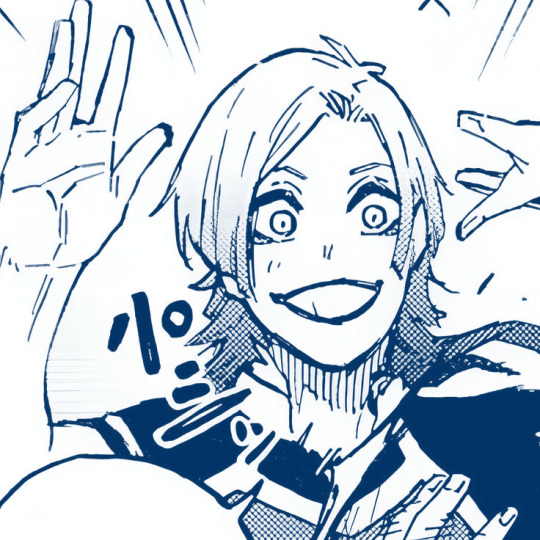
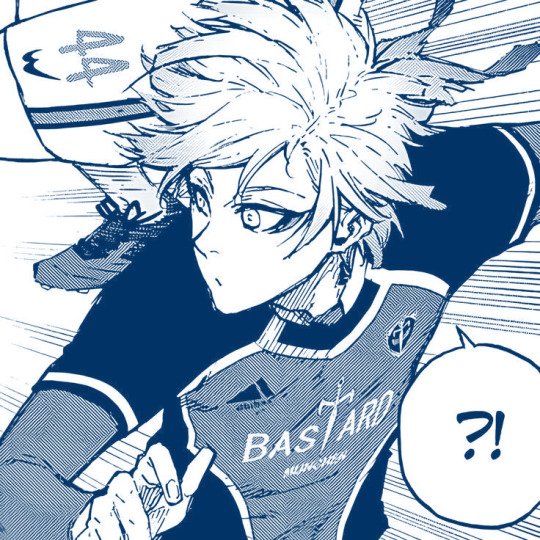

Michael doesn't know what it's like to love anyone other than himself, and he probably never will. His childhood traumas definitely changed the way he thought and saw the world when he was still a child. The fact that he wanted to be loved even when he was going through all of that doesn't make this contextualization taken directly from an unreliable source, which is my mind, any better. Behind all that narcissistic arrogance, there's still a fragment of that mentally fragile boy who lived with his abusive father. Kaiser hates that, he wants to get rid of it as soon as possible, but he's aware that traumas are never completely forgotten or simply left in his mind, they would just become another one of the thousands of memories buried in his hippocampus. Kaiser has learned to live with his traumas, although there are times when he physically takes it out on himself in addition to his own mental exhaustion, but damn, he's fully aware that his interior responsible for controlling his entire body, mind and actions is totally fucked up. He can't make an effort to love someone, maybe he'll use you for his own benefit if he finds it useful, he'll fuck your body when he's mentally frustrated to try to get rid of that familiar feeling that eats away at his insides through the most impure means a human being can provide. Sex is temporary, memories aren't. Sometimes he won't even look you straight in the face because he thinks you don't deserve the emperor's gaze. You are just there to relieve his frustrations. There's nothing else he wants from you other than that. This twisted cycle will last until Kaiser gets tired of you and looks for someone else. He knows he'll have no problem finding someone else when he's a man with striking features, a handsome face that masks the rot beneath, but what's eating away at his body on the inside isn't so pretty. That's another matter.
I tried to fix it and changed some words.
#bllk#blue lock#bllk headcanons#blue lock headcanons#michael kaiser#kaiser michael#kaiser smut#michael kaiser angst#bllk manga#blue lock anime#blue lock smut#bllk smut#one shot#be aware of what you are reading#mine#tw: kaiser#michael kaiser x you#kaiser x reader#kaiser x gn reader#bllk x gender neutral reader#gn reader#gender neutral reader#do not take me seriously#don't take anything related to this account seriously#yoonginismobsessed#maybe a little ooc
73 notes
·
View notes
Text



@ null
Let me go ahead and give you a proper response, because I think this needs to be addressed.
Fucking hell.
I wrote a whole probably better worded response to this that Tumblr destroyed so you get this.
*deep sigh*
Lets try this again slowly. You are obviously very upset and running with things completely out of context. It's incredible to me that of all the things said in that post, you somehow came to the conclusion that my argument is that it's okay to draw naked kids. Truly incredible.
I am not defending pedophilia. Pedophilia does not need to be defended, it is a mental disorder. The word "pedophile" is not the same word as "child predator" let's get that very clear right away. I don't care how uncomfortable it makes you. I refuse to moralize primal human psychology.
The point of my post was to stop moralizing primal human psychology, desires and fixations. Full stop.
I am not defending illustrated CSAM, I am not saying it's okay that this content exists or encouraging its creation. I am making the very real and important distinction between illustrated contextual fantasy and illegal CP content. No, drawing r34 of a cartoon character isn't going to immediately catch you a charge. It is highly dependent on the context and the way the act is portrayed. There is an immense amount of nuance here and I'm not going to discount it to make your life easier.
I'll say it again: We as a people do not know how to determine why something is actually wrong. You yourself clearly do not.
The issue with the situation you describe has always been children being exposed to inappropriate content. It does not matter if it is illustrated, real, written in text or spoken aloud.
Children being exposed to any type of inappropriate content is traumatizing. It is not the existence of porn or fetish content that hurts kids, it is being exposed to it by predatory adults.
This content cannot harm children unless an adult is actively harming them. Your abuser could have used any kind of content to groom you. Your issue is not with the existence of fetish content or grown adults engaging with consenting adults in private.
Your issue is with *children* being *exposed* to inappropriate material. And fetish content, sexual content, violent content, is not for children.
Yes, consuming extreme and illegal fetish content can increase your predisposition to causing harm.
But fantasized illustrated and exaggerated content is not snuff. Eroticism is not porn and porn is not snuff. Two consenting adults engaging in pet play is not bestiality. Furry porn is not bestiality. Age play is not pedophilia. There are no children and no animals involved in this situation. Watching real depictions of crimes will erode someone's sensitivity to it., that is true. Watching campy exaggerated horror movies does not make you a violent freak who loves murder. Finding an image of a fake anime girl hot does not directly translate to finding real children attractive or wanting to engage with them. I'm so sick of us watering down what pedophilia is.
Adults engaging with other adults does not harm children. Full stop. Is it weird? Yes, as fuck. It's allowed to be weird and gross. That does not make it harmful.
I said in my reblog that inappropriate content does not belong on all ages sites. Extreme fetish content must be restrained to monitored and moderated adult only forums so that illegal content can be identified and investigated. Porn is traumatizing for children to see in general. That does not mean we need to ban porn for the entire population. The issue isn't the porn. It is the access to it by minors.
Does this mean illustrated CSAM okay? No. I said that multiple times, idk how many times I have to say it. No. No. No it is not definitely okay. Not everything needs to be so aggressively black and white. It does not have to be the worst thing in the world to be a red flag. It is not normal. It is still problematic, it is still inappropriate. It is still a red flag. It is still risky.
What that means is that we need to approach these things with consideration and respect so that it does not evolve into something dangerous.
It means keep fetish content where it belongs, on adult sites.
It means report fetish content when you see it on public platforms and social media sites
It means keep adult conversations between adults.
Predators exposing kids to inappropriate content is not the fault of sex workers trying to make a living. Predators exposing kids to inappropriate content is not the fault of adults coping with their condition in non-harmful and private ways.
Pedophilia is a mental disorder, and I refuse to moralize human psychology. The mass majority of people who suffer from this condition are former victims of childhood sexual assault. I am not defending predators or predatory behavior. Not all pedophiles are predators and I refuse to persecute a group of people with no justification other than my discomfort. I don't care how hard that is. Life isn't easy. I am willing to preserve the uncomfortable nature of the truth if it means preserving the truth.
People who have problematic, unethical and illegal fetishes, kinks and, fixations deserve space and empathy. I will say it 1000 more times.
You observing behavior between sexual predators means nothing to me. I am not going to assert that all people who engage with paraphilias act the way that sex traffickers do. Nor am I going to assert that all drug users are irresponsible addicts. Again, too simple of an explanation for an incredibly complex topic and a gross generalization of a huge group of people. I will not treat an entre population as if they are corrupt. Doing so does not stop the corruption.
You still think I'm a deplorable monster? Block me.
And the next time you see disturbing content that is not for you, Block that too.
Block and avoid things that make you feel uncomfortable and unsafe. Do not engage in conversations that are not meant for you.
I swear there always has to be at least one person who takes a single sentence completely out of context and just runs with it, its like one of the inevitabilities of the universe or something. I guess it wouldn't be a Luciferian take if it wasn't unjustly distorted by at least one person so.
#like really guys#I get it#It is a sensitive topic that can elicit very strong feelings#but if you are too emotional to think rationally#you may not be ready to engage with this conversation#so dont#Don't trigger yourself and revive past traumas by engaging in conversations you know you cannot handle#because you simply will not do the conversation justice#or give it the nuance it deserves#lucifer devotee#theistic luciferianism
33 notes
·
View notes
Text
on this blank canvas i paint is the best ena event and here's why:
so the story is structured as past vs. present, with significant flashbacks to contextualize the decision that ena currently faces. in the past, she was so bad at taking criticism that she ran away and cut herself off from opportunities to improve.
so you might expect that in the present, she'll prove she's become strong enough to handle criticism with grace. but that's not what happens. returning to art class makes her terrified and miserable. the event card literally shows her holding back tears.
but she does it anyway.
in the flashbacks, we find out that her dad didn't necessarily call her untalented, he called her too sensitive to be an artist. this event is where she proves him wrong. she is still sensitive, but she’s also passionate and hard-working. the fact that she's able to feel her feelings now instead of running away from them is a sign of growth.
but then, why is she able to do it now? because she has niigo. she has kanade who needs her, mizuki who understands her, mafuyu who challenges her. for perhaps the first time in her life, she has the unconditional support that can stop her from crumbling in the face of adversity.
#have i mentioned i love ena#ena shinonome#project sekai#pjsk#nightcord at 25:00#n25#pjsk ena#kanade yoisaki#mizuki akiyama#mafuyu asahina#meta#pjsk meta#analysis#character analysis#character development#overanalysis
60 notes
·
View notes
Note
People are talking about how First has always been very generous & kindhearted & saying how a lot of their colleagues talked about it too. Do you know where I can find the clips or interviews? I think I got to know through you how he gave 15k baht to mark & how KT said he is so kindhearted that some of his friends take advantage of him. I am really sucker for fkt praise by colleagues so I really really wanna know
i've gone through some of fk's generous moments in this post as we're always more likely to see them talking about it in response to each other. it's not money related, but we could see a lot of that kind nature from khaotung when they were on safe house together, too.
lookjun is someone who has talked about first especially, bc they worked together in her first series (not me) and later in only friends, and she said during a live she did with pepper that he's cute, kind and annoying, besides being really good at memorizing his lines. lookjun also joked that fk are like a real couple and that first likes teasing her and khaotung just laughs at them.
p'jojo has also talked about first and how he made sand a more dimensional character bc he's a sensitive person. to add to first giving mark 15,000 baht to buy a ipad, we also got khaotung giving him 2,000 baht to add to the total.
there's this live from forever ago, where first is wearing a monkey pajamas, even though it's not of his liking. his mom gave it to him and he didn't want to make her sad by not wearing her gift so every now and then, he said he'd wear it.
i know people really like firstmix, but here i am, on the khaomix trenches. on season 1 of safe house, they eating and mix mentioned wanting to eat crab bc i think they had already finished a portion or maybe they didn't make it that day, and since he was already done eating, he went to the kitchen to make mix some crab to which mix looked actually touched (pond even calls him good boy which is the sweetest). we also got khao teaching earth how to play the guitar in tiny, and in general, safe house season 1 khaotung was the most spoiled, baby girl princess [ 1 2 3 ]. i wish i knew more thai to understand them more. (this season even gave us fk crumbs even though first wasn't in the house. someone praised khaotung bc he made the bed, and first interjected saying he never does that, and khaotung agreed saying he usually sleeps in the couch).
in the same khaomix topic, we also had earthmix talking about first and khao during earthmix space. they talk about how khaotung is a kind and good-heartened person who's always calm, cool and collected who likes spoiling his friends. they also say that first is a nice kid. he's talkative and alert and gets along with people in their first encounter.
not to mention how polite and attentive they are to everyone who meets them, and also how caring they are about their fans (like when telling fans to eat during and after events). and they always talk about being kind to each other and others, too.
but just to contextualize this post, this whole conversation about them being good-natured people all came about bc of gun's picture showing first knelling down to (apparently) buy some flowers from a kid late at night.

and people remembered the story khaotung told about winning in the lottery after buying all of the tickets from a granny who was selling them because he wanted her to go home.
they are just very sweet people.
edit: i'd like to also add this video of khaotung putting food on mae godji's plate when they were on live for grab food 99, since she was busy doing promo and couldn't place it for herself, he just kept making sure she had food too before they ate everything.
#bibs ask#Anonymous#first kanaphan#khaotung thanawat#firstkhao#firstkhaotung#fk lore#i couldn't find many interviews tbh#we know people are fond of them for being good natured people by off hand comments#and also bc every person who meets them seem to want to adopt them as package deal#hello poon welcome to the club#but most of the things they do like everything else about fk really we don't know unless someone else talks or posts about it#like the gun picture we wouldn't know first did that if gun wasn't with them#i don't even think either of them reposted that picture on insta like they usually do
33 notes
·
View notes
Note
This is a bit of an odd question- but when a spirit transforms into their human body, are they completely human? Can they still perform magic? If they're human, does that mean that Calamity or Corn could safely be in the cold if their human form? (Without, you know, their poppy cloaks)
While Human, they can only perform the magic that they prepared for themselves while nagual just like a regular human could.
The weaknesses that they have in nagual form (such as Corn and Calamity's reaction to cold) are re-contextualized for someone human. As such they are not going to fall asleep in the cold, but, they would still maintain a human over sensitivity to it.
59 notes
·
View notes
Text
I do find it quite insane that people think Bridgerton season 3 was too rushed. I really think Colin's every plot line has been to bring him closer to Penelope. I think there's plenty of gifsets already that show the little affectionate or longing looks between Colin and Penelope starting from season 1. But I don't even mean those when I say that Colin is written in a way that perfectly matches Penelope's fat girl romance story. People skirt around calling Penelope a fat girl and therefore her romance one that's strife with struggles around being fat because somehow that is what they think will betray their fatphobia. But it's not fatphobic to recognize the way that a fatphobic society has fucked with both Colin and Penelope's heads. Colin's incredibly strong, incredibly illogical crush on Marina Thompson, Penelope's cousin, suddenly makes so much sense when you contextualize it as his feelings for Penelope being misguided onto the closest eligible target. (It honestly even felt that way when I watched season 1 as it was coming out.) Because here's the thing about Penelope, right? That society has deemed her ineligible. A fact that we know Colin is painfully aware of by the end of season 2 when he declares to his 'friends' that he would never court her. The same friends he calls shallow to their faces in season 3. So was it surprising that Colin's whole arc in season 3 was about shaking off the shackles society has on his decisions and more importantly, his desires. Because Colin isn't just trying to get by with society's expectations like Anthony was, no. He was trying to change himself to like it. He was trying to buy into it. Because society made him miserable before and maybe embracing it would make him happier. There's a reason he's so passionately anti-Whistledown. She represents those very shackles of society that ironically keeps him from acknowledging his feelings for Penelope. Colin has been in love with Penelope for just as long as she has been in love with him, if not more. But Penelope wasn't the only one who thought that was impossible simply because she was fat. In fact, this is a very common fat girl dating experience, you meet men who would absolutely fuck you, heck they can even love you in their own way but they're not ready to face the shame of other's judgement in acknowledging you. Colin's every appearance on this show starting from season 1 has been setting him up to release those shackles. He wanted to for Marina, but his feelings for her were not genuine. He chased her out of obsession, not love and I think that distinction was infinitely clear to Marina. She could never inspire this soft, sensitive man to harden his backbone in a way that Penelope can. His love for Marina brought him anguish, his love for Penelope brings him joy. The Duke and Daphne barely had a conversation that entire season, Kate and Anthony met and created all of this havoc for what? Colin and Penelope are the only two, whose emotional connection has been established over the course of three whole seasons. Lots of criticisms can be made of their romance I'm sure, but rushed? Listen, I know why people think it's rushed and while season 1 and season 2 Colin would really really care that you think Penelope is unfuckable but season 3 Colin doesn't have a single fuck left to give.
#bridgeton season 3#bridgerton#polin#colin bridgerton#penelope featherington#I have watched all of season 3 thrice already#and did a s1 and s2 polin rewatch#fat girl romances will never not be special to me
114 notes
·
View notes
Note
How do you feel about jewish supernatural creatures being portrayed in media? Is it okay if done correctly, since it is a closed religion? I'm really curious, especially since you obviously know so much about them.
I also want to say that I love your art! And I love being able to learn more about these creatures.
thank you for the kind words, i appreciate it!
i have to say i'm confused by the question, or possibly its framing - i'm not sure what Judaism being a "closed religion" has to do with portraying creatures from folklore in media. "closed religion" is a term people generally seem to use when they're talking about not appropriating the actual religious/cultural practices of a (usually contextually marginalized) religion that you don't belong to. recently i've seen some pushback against the term "closed practice/religion" for Judaism, as it's not literally true. yes, Judaism is for Jews, but anyone can convert to Judaism - it's just that it's a whole process that involves a lot of learning & then being accepted by a Jewish community. to my knowledge, "closed practice" as a term grew out of the pagan/neo-pagan community anyway & was used to describe any religion whose symbols, deities & practices weren't socially considered fair game for use in your own personal spiritual practice - i have a lot of thoughts on this odd sort of "restaurant view" of religion & culture, where some things are at a free-for-all buffet so you can just take what you want (who put them there?) while other things are only served at certain tables by reservation (is anyone else ever invited?), but that's a whole other post.
i'm assuming you're asking how i feel about non-Jewish people portraying creatures from Jewish folklore in various kinds of media, & the answer is that it totally depends on the thing & how it's done? i definitely don't subscribe to the idea that creators should never step outside their own experience/culture. i do think portraying (elements of) other cultures is something that should be done carefully & sensitively, ideally with input from members of that culture! unfortunately, it is very, very easy for creators to unintentionally fall into antisemitic tropes & stereotypes, because those ideas are so old & so pervasive, especially when it comes to monsters & other supernatural creatures (Jews having been literally demonized by Christian culture for centuries). i think if you're not Jewish, then making sensitive, educated work about Jewish monsters is probably hard mode, but that isn't to say it can't be done. i can think of plenty of bad examples off the top of my head, but i'm sure i could come up with some good ones too if given the time.
of course, this is all just my opinion, & should not be taken as a ruling on what's "okay"! other Jews will agree & disagree with me, which is fine & good. :)
249 notes
·
View notes
Text
The Dos and Don’ts of Giving and Receiving Constructive Criticism
Some of these should be painfully obvious and yet. They come from experience.
Receiving feedback:
Do
Understand that a criticism of a character’s thoughts, actions, morality, and choices are likely not a criticism of you as an author, unless the character is an author insert
Understand that they are being paid to critique how successfully you told an entertaining story, not pander to your trauma dumping
Understand that critiquing a book’s success as an entertaining story means that how much you yourself connect with or love a character or scene or plotline is irrelevant if it doesn’t make a compelling narrative
You might have written your book for yourself. Your editor is a different person with their own human biases and perspectives. If you just want to pay someone to stoke your ego, make that 100% clear up front.
Stand up for yourself and clarify where necessary if some details were overlooked or if explaining outside the narrative can better contextualize anything confusing or lacking detail.
Stand up for yourself in what feedback you are expecting, and what degree of criticism you’re willing to endure. An editor can let more or less of their own views show depending on what you ask for.
Stand up for yourself if your editor delivers inadequate or useless feedback. You’re paying them for a job, and you deserve to have it done properly.
Try to separate dislike of a book from dislike of yourself. It’s not easy, but the goal is to fix your book that you’ve already spent a lot of time writing, and they’re only trying to help.
Remember that your author insert is subjected to the same level of criticism as any other character, and that you asked for this.
Keep an open mind and be prepared for feedback that you don’t like, because you can’t please everyone. Your editor should be able to tell you whether or not a scene or character, or plotline works separate from their own personal tastes.
Don’t
Argue with your editor over their religiosity or lack thereof and insist that adhering to genre expectations means they “worship the god of [genre]”. (really, argue with your editor over anything like this, e.g. their own sexuality, religiosity, gender, socioeconomic status).
Argue with your editor while still expecting more work from them as if your aggression will in any way positively impact their perception of your book.
Insult your editor’s intelligence for not understanding your jargon and attempts to sound smarter than you are.
Get mad when your editor sees right through your BS and calls it like they see it, specifically your self-insert Mary Sue protagonist.
Insist that the solution to better understanding your book is for that editor to do extensive homework on your niche topic. If it’s a niche book for niche audiences, hire an editor who’s already knowledgeable about that niche topic.
Equate a bad review and opinion of the book with unprofessionalism. These can overlap, but they are not interchangeable.
Forget that your book is probably meant for leisure and entertainment, and your audience is under no obligation to read “until it gets good,” when they can go do literally anything else. Your first job is to entertain, if you write fiction.
Giving Feedback:
Do
Pay attention to your client’s wants and needs and expectations. If they’re more sensitive to bad feedback, do your best and stay as objective as possible. You can’t please everyone, either.
Helpful feedback includes an explanation of why an element needs work and how it can be improved. Saying “I hate this” with nothing else helps no one and just makes the author feel bad with no direction of how to make it better.
Communicate beforehand how much of your own personality your author wants from you. Do they like personal opinions and your personal reactions to the text, or do they want it as impersonal as possible and solely focused on the structure of the narrative? This might avoid a mess.
Remember to leave notes of where things worked well to balance the criticism. Even a simple “this is good” highlighting a line or a paragraph or two helps keep authors motivated to keep writing. I firmly believe that no book is completely unsalvageable.
Make it painfully clear with no room for debate that criticism of a character is not criticism of the author, unless it's an author insert, in which case the author absolutely asked for it.
Make it clear that you are just one person and these are all suggestions, not laws.
Don’t
Let your own personal opinions cloud your judgment of whether or not someone with different tastes could enjoy the book.
Unless given permission, get too personal with the narrative and reach beyond what’s written on the page.
Do more than what you’re paid for. You’re an editor, not a therapist for the writer’s trauma dumping.
Forget to wrap up all your thoughts in a condensed format that the author can reference, as opposed to endlessly scrolling through the manuscript trying to summarize your points for you.
Walk away with absolutely nothing positive to say about the manuscript. Even if it’s awful on every front, the writer still tried and that deserves merit.
This is from my personal experience beta and sensitivity reading, and dealing with other beta and sensitivity readers. We are all human and these jobs are not one-size-fits-all and there aren’t really hardline rules as every author, editor, and manuscript is different with different needs.
Just some things to keep in mind.
But also, for the authors who do write self-insert Mary Sues: You are in for a very rude awakening if you expect anyone other than yourself to adore your book with zero criticism. If you really just want someone to proofread and look for typos, tell them.
#writing advice#writing#writing resources#writing a book#writing tools#writing tips#writeblr#editing#feedback#constructive criticism#how to give feedback#dos and donts
92 notes
·
View notes